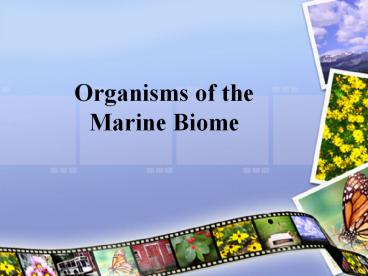Organisms of the Marine Biome - PowerPoint PPT Presentation
1 / 20
Title:
Organisms of the Marine Biome
Description:
Marine Biome Essential Questions What are the types of organisms in each marine life zone? How are organisms distributed in the marine biome? Fish Daily Planet in the ... – PowerPoint PPT presentation
Number of Views:158
Avg rating:3.0/5.0
Title: Organisms of the Marine Biome
1
Organisms of the Marine Biome
2
Essential Questions
- What are the types of organisms in each marine
life zone? - How are organisms distributed in the marine biome?
3
FishDaily Planet in the Classroom
- http//learning.aliant.net/Player/ALC_Player.asp?P
rogIDDISC_DPC-37 - 60mins
4
What are the types of organisms in each marine
life zone?
5
Epipelagic
- fish such as
- Tuna bigeye, yellowfin, albacore, northern
bluefin - Many sharks
- Dolphin fish
- Jellyfish
- Basking shark
- Whale shark
- Sprats
- Anchovies
- Sargassum fish
- Great baracuda
- Jacks
- Swordfish
- Ocean sunfish
- Zooplankton
- Algae
- Plants
- Sargassum seaweed
- Turtles
6
(No Transcript)
7
Epipelagiccharacteristics of organisms
- predator fish have a deeply forked tail and a
smooth body shaped like a spindle tapered at both
ends and countershaded with silvery colours - visual predators can use their eye sight
8
Mesopelagic
- Animals such as
- Swordfish
- Squids
- Wolffish
- Wolf eels
- a few species of cuttlefish
- chain catshark
- California Headlightfish
- Sabertooth fish
- Coccorella atrata
- Antarctic toothfish
- Barreleye
- Stoplight loosejaw
- Longnose lancetfish
- many bioluminescent organisms live in this zone
- mesopelagic fish make daily vertical migrations,
moving at night into the epipelagic zone - fish have a swimbladder
- muscular bodies, ossified bones, scales, well
developed gills and central nervous systems, and
large hearts and kidneys - visual predators with large eyes
- lack defensive spines
- use colour to camouflage them
9
(No Transcript)
10
Bathypelagic organisms
- Organisms such as
- Lanternfish
- Marine hatchetfish
- Giant squid
- smaller squids
- Dumbo octopodes
- Sperm whales
- Viperfish
- Ridgehead
- Lightfish
- Frill shark
- Sponges
- Brachiopods
- Sea stars
- Echinoids
- Anglerfish
- Bristlemouth
- Fangtooth
- Daggertooth
- Barracudina
11
(No Transcript)
12
Bathypelagic characteristics of organisms
- some species do not have eyes
- fish in this zone have become very energy
efficient - many have slow metabolic rates to
conserve energy - unspecialized diets, being willing to eat
anything that comes along - prefer to sit and wait for food rather than waste
energy searching for it - fish here have weak muscles, soft skin and slimy
bodies without scales - fish are small, many about 10 centimetres long,
and not many longer than 25 cm - often have extensible, hinged jaws with recurved
teeth - gills, kidneys and hearts, and swimbladders are
small or missing - most important sensory systems are usually the
inner ear, which responds to sound, and the
lateral line, which responds to changes in water
pressure - fish are black, or sometimes red
13
Abyssopelagic
- Organisms such as
- several species of squid
- black swallower
- tripod fish
- deep-sea anglerfish
- giant squid
- Echinoderms
- basket star
- swimming cucumber
- sea pig
- marine arthropods
- sea spider
- species living at these depths have evolved to be
transparent and eyeless - creatures have underslung jaws
14
Hadopelagic
- Organisms such as
- Jellyfish
- Viperfish
- Tube worms
- Sea cucumbers
- deep sea angler fish
- creatures have adapted with reduced eyesight,
having very large eyes for receiving only
bioluminescent flashes - most of the bottom dwelling creatures lack any
pigmentation
15
Demersal Zone
- Organisms such as
- Giant grenadier
- Rattails
- Brotulas
- Eels
- Eelpouts
- Hagfishes
- Greeneyes
- Batfishes
- Lumpfishes
- Fish are active and relatively abundant
- Fish are muscular with well developed organs
- Photophores are usually absent
- Eyes and swimbladders range from absent to well
developed - Fish are usually long and narrow
16
(No Transcript)
17
Benthic Zone
- can be divided into
- Flabby body types
- they have a reduced body mass
- low metabolic rates
- Robust body types
- are muscular swimmers that actively cruise the
bottom - blind
- Organisms such as
- Cusk-eel
- Orange roughy
- Patagonian toothfish
- Pacific hagfish
- Blotched fantail ray
- Tripod fish
18
(No Transcript)
19
One OceanBirth of an Ocean Chp 2
- http//oneocean.cbc.ca/series/episodes/1-birth-of-
an-ocean?auto_load_clip1431659624 - Question Sheet provided
- 17mins
20
How are organisms distributed in the ocean?































